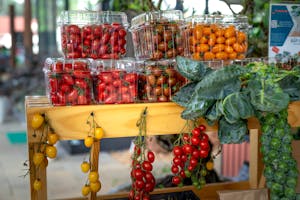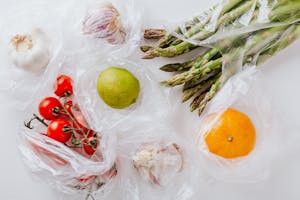June 19, 2025

Despite common misconceptions, plastic packaging plays a fundamental role in supply chains and offers sustainability benefits that shouldn’t be ignored. While alternatives may seem more eco-friendly at first glance, data-driven analysis shows that plastics can significantly reduce material use, energy consumption, and greenhouse gas (GHG) emissions.
When measured holistically across the full product lifecycle, plastics often outperform other materials in environmental impact. Today’s article breaks down the important sustainability benefits of plastic packaging and its role in maintaining efficiency, cutting down on waste, and meeting regulatory demands while supporting long-term operational strategies.
One of the most compelling advantages of plastic packaging is its material efficiency. Compared to alternative materials such as glass, aluminum, and paper-based composites, plastic packaging is, on average, 3.6 times lighter. With less material required, resource use decreases across production, shipping, and waste management.
Beyond its weight, plastics require fewer raw materials to achieve the same functional benefits, reducing the overall demand for natural resources.
Optimized processes lead to lower energy consumption and a reduced environmental footprint from raw material extraction and its subsequent processing. The strategic use of plastics in packaging supports product protection while cutting down on unnecessary waste.
Plastic packaging is often scrutinized for its overall environmental impact, yet lifecycle assessments tell a different story. Traditional packaging materials contribute 1.7% of the total consumer carbon footprint, whereas plastic packaging accounts for just 0.6%, which is a striking difference in environmental load.
The GHG prevention benefits of plastic packaging are five times greater than the emissions produced during its manufacturing and recovery processes. A primary factor is its ability to extend food shelf life, preventing spoilage and reducing the emissions associated with wasted food production.
These advantages, coupled with recyclability and energy recovery potential, position plastics as an effective tool for reducing emissions across the entire supply chain.

Beyond looking at sustainability, plastics provide tangible cost advantages in transportation and storage. Their lightweight nature reduces fuel consumption and optimizes freight loads, leading to lower logistics costs and emissions.
A truck carrying plastic-packaged products can transport more units per load compared to heavier alternatives, driving efficiency in distribution networks. Furthermore, plastics help preserve perishable goods by preventing possible damage and helping to extend shelf life. For food supply chains, this means lower spoilage rates and higher revenue retention.
The cost savings associated with waste reduction, product integrity, and efficient distribution create a strong business case for continued investment in plastic packaging solutions.
Plastic packaging delivers measurable environmental benefits, particularly in energy use and waste prevention.
If plastic were substituted with other materials, energy demand across the life cycle would rise by a factor of 2.2, adding 1,240 million gigajoules per year, the equivalent of heating 20 million homes.
Additionally, the net reduction in overall waste is significant. Recycling and recovery initiatives lower the total energy demand of plastics by 24% while cutting greenhouse gas emissions by 27%.
Even without recycling, plastics still outperform other materials in emissions impact. These figures underscore the importance of integrating plastics into sustainability strategies rather than eliminating them.
With growing environmental regulations, businesses must document their sustainability efforts effectively.
Plastic packaging offers strong compliance advantages due to its documented environmental impact data, established recycling programs, and alignment with sustainability reporting frameworks, such as carbon footprint assessments and ESG disclosures.
Companies that are leveraging plastic packaging can position themselves favorably in the eyes of consumers by demonstrating a reduction in emissions, waste, and broader resource consumption.
Regulatory bodies increasingly focus on lifecycle sustainability rather than material composition alone, making it essential for businesses to highlight data-backed benefits when engaging with stakeholders and policymakers.

The drive toward sustainability requires companies to evaluate long-term material viability. While alternative materials may be promoted as “greener” solutions, they often come with higher energy costs, logistical inefficiencies, and other supply constraints.
A material substitution risk assessment reveals that replacing plastics would lead to increased emissions, higher packaging mass, and more complex waste management challenges.
Strategic investments in advanced recycling technologies, lightweight plastic alternatives, and sustainable polymers allow plastic packaging to remain adaptable to future regulations and market shifts. By choosing to embrace innovation rather than abandoning plastics outright, businesses can enhance resilience and continue advancing sustainability objectives.
Plastic packaging remains an essential tool for energy efficiency, waste reduction, and supply chain optimization. Rather than viewing plastics as a problem, businesses should harness their advantages while investing in sustainable improvements.
Leading the way in sustainable packaging requires industry leaders to stay informed and take proactive steps. Join PLASTICS, the Plastics Industry Association, to gain access to the latest research, recycling initiatives, and industry collaboration opportunities.
Together, we can drive meaningful advancements in packaging sustainability while maintaining operational efficiency and environmental responsibility.
PLASTICS and the Future Leaders in Plastics (FLiP) Committee are devoted to supporting and encouraging the next generation of plastics leaders who will play a crucial role in the innovation, technology and future of the plastics industry. FLiP’s mission is to provide young professionals under the age of 40 the exposure, education and resources they need to build lifelong careers in plastics. Want to join? Want to get your employees involved? Email: [email protected]